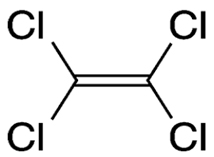 What is PCE?
What is PCE?
Perchloroethylene (PCE), also known as tetrachloroethylene, is a chlorocarbon with the formula Cl₂C=CCl₂. It is a colorless liquid widely used for dry cleaning of fabrics, hence it is sometimes called “dry-cleaning fluid”.
Uses
Perchloroethylene (preceded by trichloroethylene) is used for dry cleaning and textile processing, as a chemical intermediate, and for vapor degreasing in metal-cleaning operations. Perchloroethylene became the most commonly used dry-cleaning solvent in the 1950s, replacing carbon tetrachloride, which was more toxic, and trichloroethylene, which was harsher on fabrics
Sources & Potential Exposure
Perchloroethylene is widely used for dry-cleaning fabrics and metal degreasing operations. Effects resulting from acute (short term) high-level inhalation exposure of humans to perchloroethylene include irritation of the upper respiratory tract and eyes, kidney dysfunction, and neurological effects such as reversible mood and behavioral changes, impairment of coordination, dizziness, headache, sleepiness, and unconsciousness. The primary effects from chronic (long term) inhalation exposure are neurological, including impaired cognitive and motor neurobehavioral performance. Perchloroethylene exposure may also cause adverse effects in the kidney, liver, immune system and hematologic system, and on development and reproduction. Studies of people exposed in the workplace have found associations with several types of cancer including bladder cancer, non-Hodgkin lymphoma, multiple myeloma. Tetrachloroethylene has also been detected in drinking water supplies from contaminated groundwater sources.
Federal Regulations
EPA has classified perchloroethylene and trichloroethylene as likely to be carcinogenic to humans.

 Americas
Americas Europe
Europe Français
Français Deutsch
Deutsch Italiano
Italiano Español
Español


